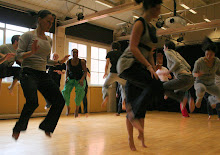The term “physical theatre” has quite a variety of opinion because some theorists claim that physical theatre falls into dance theatre and some will say there is a clear distinction from one genre to another.
Ana Sanchez-Colberg states “At a surface level, the term has been collectively used to identify an eclectic production commonly understood to be one which focuses on the unfolding of a narrative through physicalized events”. (2007. pg 21)
Throughout my training my understanding of physical theatre has changed in many ways. Originally I saw physical theatre as dance theatre, simply because everything looked as if it was choreographed to look pretty. However once we began devising work my understanding has changed drastically.
I now firmly believe that physical theatre has derived from dance theatre but has a meaning behind the movements. I believe that pedestrian movements separate dance theatre from physical theatre, pedestrian movements give the audience a need to decode the body as a sign to read further into what they are seeing compared to dance where the audience only tend to watch what is happening on stage rather than thinking about why they are moving.
2.
Ana Sanchez-Colberg says “The term itself – ‘physical theatre’ – denotes a hybrid character and is testimony to its double legacy in both avant-garde theatre and dance. It is precicisely this double current of influences which needs to be taken into consideration in any attempt to delineate specific parameters of the new genre.”
I agree in what Ana Sanchez is stating because physical theatre has not yet got a clear, distinct meaning. There has been an argument amongst theorists that physical theatre should fall into dance theatre and some think that it should be classed as a different type of theatre. Physical theatre does have choreographed sections which is where dance theatre becomes a part in the debate. However combined with pedestrian movements which are not associated with dance theatre, physical theatre is a hybrid performance genre because it combines two different theatre types and merges them together to create something innovative.
3.
Jasmin Vardimon company fall into the physical theatre genre. The company combine choreographed sections and pedestrian movements throughout their work.
The company add, “Vardimon accentuates her work with an acute observation of human behaviour”. This is something which physical theatre focuses on.
When watching ‘Yesterday’ it was clear to see how her work was crafted more towards the physical theatre genre and not dance. There were choreographed sections throughout the piece which featured pedestrian movements happening at the same time, this lost any meaning of dance theatre.
Having experienced a workshop with the company you can tell how they begin with an initial concept and then turn it into something which looks very creative. We started by walking in a group doing the same movements but then were told we had to imagine wind was controlling our movements, this type of work is clearly physical theatre and not dance theatre simply because it was not all about looking pretty but having a reason to move.
References
Keefe, J & S Murray (2007) Physical Theatres: A Critical Reader London: Routledge
Jasmin Vardimon Company (2008) [Home Page] [online] [February 22nd, 2009]
Daniel Smith



No comments:
Post a Comment